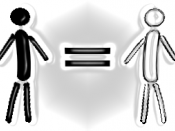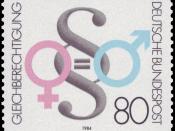The idea of women's liberation was begun simply because of sex-role differentiation in society, if the positions of men and women had been reversed, there's no doubt men would have been forced to start their own movement, but it was women who were the oppressed, and men the oppressors.
Feminism emerged in western countries at similar times. Women's liberation groups emerged as early as 1929, when the Association of Women was formed (Curthoys 1992). Many such unions and associations were formed, speaking out against the patriarchal way of society. This all arose, primarily, after the second world war. Issues such as 'equal pay for equal work,' and married women's right to work, were the prime issues raised. A political scientist from England visited Australia, Norman MacKenzie, and he concluded in 1962 that "Australian women had a long way to go before social equality could be achieved." (Mackenzie 1962 cited in Curthoys 1992 p.429)
Women's views were not taken seriously, whether on anti-war protests, or equal rights for women. Desperation for equal rights for women arose, causing them to carry out such acts as chaining themselves to bars to show their stance in the right to drink side by side with men. One leaflet handed out during a women's liberation meeting read: "We, like Vietnamese, can only be free of oppression when the profit makers no longer have the power to determine our lives." (Curthoys 1992 p.433)
Radical and socialist feminists were seeking the end of women's structural inferiority in relation to men, and were involved in the women's liberation movement, their fundamental aim being to transform society. Radical and socialist feminists are not named as such arbitrarily! These feminists are the extremists in the movement compared to Liberal feminists. An example of this is their hope for a 'fundamental...



Very nice
I found this very interesting, and it caught my attention from the start. It almost made me angry to read about how woman were/sometimes still are treated.
0 out of 0 people found this comment useful.